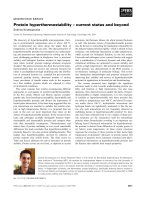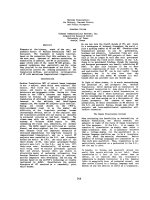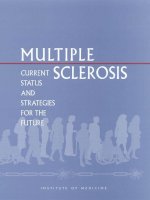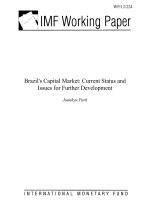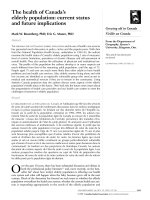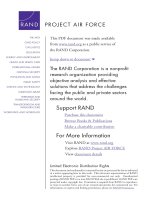Systemic vasculitides current status and perspectives
Bạn đang xem bản rút gọn của tài liệu. Xem và tải ngay bản đầy đủ của tài liệu tại đây (10.19 MB, 429 trang )
Franco Dammacco · Domenico Ribatti
Angelo Vacca Editors
Systemic
Vasculitides:
Current
Status and
Perspectives
Systemic Vasculitides: Current Status
and Perspectives
Franco Dammacco • Domenico Ribatti
Angelo Vacca
Editors
Systemic Vasculitides:
Current Status and
Perspectives
Editors
Franco Dammacco
University of Bari Medical School
Bari, Italy
Domenico Ribatti
University of Bari Medical School
Bari, Italy
Angelo Vacca
University of Bari Medical School
Bari, Italy
ISBN 978-3-319-40134-8
ISBN 978-3-319-40136-2
DOI 10.1007/978-3-319-40136-2
(eBook)
Library of Congress Control Number: 2016954956
© Springer International Publishing Switzerland 2016
This work is subject to copyright. All rights are reserved by the Publisher, whether the whole or part of
the material is concerned, specifically the rights of translation, reprinting, reuse of illustrations, recitation,
broadcasting, reproduction on microfilms or in any other physical way, and transmission or information
storage and retrieval, electronic adaptation, computer software, or by similar or dissimilar methodology
now known or hereafter developed.
The use of general descriptive names, registered names, trademarks, service marks, etc. in this publication
does not imply, even in the absence of a specific statement, that such names are exempt from the relevant
protective laws and regulations and therefore free for general use.
The publisher, the authors and the editors are safe to assume that the advice and information in this book
are believed to be true and accurate at the date of publication. Neither the publisher nor the authors or the
editors give a warranty, express or implied, with respect to the material contained herein or for any errors
or omissions that may have been made.
Printed on acid-free paper
This Springer imprint is published by Springer Nature
The registered company is Springer International Publishing AG Switzerland
To be fully aware of one’s own ignorance is an irrepressible
incitation to the pursuit of knowledge.
v
Preface
This volume seeks to provide a comprehensive overview of the systemic vasculitides, an extremely heterogeneous group of diseases characterized by inflammation
and necrosis of different-sized blood vessels. With a few exceptions (e.g., HCVrelated cryoglobulinemic vasculitis and HBV-positive polyarteritis nodosa), the etiology of these clinical conditions remains unknown. In spite of their relatively low
prevalence, the systemic vasculitides have been the object of recent, intensive, basic,
and clinical studies. For this reason, it can be safely stated that this group of diseases
is one of the most rapidly progressing areas of clinical medicine, as evidenced by
the dramatic achievements in terms of clinical remission and overall prognostic
improvement.
The pathophysiology of the vasculitides is multifactorial and thus in most cases
poorly defined. Among the many potential influences on disease expression, sex,
ethnicity, and genetic as well as environmental factors are likely to play a role. In
addition, the vascular damage characteristic of the systemic vasculitides may be the
result of autoimmune responses, such as antineutrophil cytoplasmic autoantibodies,
anti-endothelial cell autoantibodies, immune complex deposition, an immune
response to foreign antigens or infectious agents, and T-lymphocyte responses with
granuloma formation.
The general aims of this book are:
(i) To provide an in-depth update of the major pathogenetic, genetic, and clinical
advances in the field encompassing the vasculitides, including, for each condition, a summary of the most cogent information scattered in the medical literature but not always readily retrievable
(ii) To describe not only conventional treatments, but also the more recently developed and tested drugs as well as efforts at patient-tailored therapies, especially
for patients with refractory and relapsing disease
(iii) To point out future directions of research that, while challenging, are likely to
be profitable in terms of improved diagnosis and therapy
vii
viii
Preface
If this book serves as a stimulating resource for basic and clinical researchers and
specialists in related disciplines, as well as practicing physicians and advanced
medical students interested in this fascinating branch of medicine, our efforts as
editors will have been fully rewarded. The lion’s share of the merit should, however,
be given to the international contributors who accepted our invitation to collaborate
in this project and who, in doing so, were able to impart the knowledge gained during their multiyear experience in this field.
Bari, Italy
Franco Dammacco
Domenico Ribatti
Angelo Vacca
Contents
Part I
Biology of Blood Vessels, Experimental Models
and Nomenclature of Vasculitides
1
Morphofunctional Aspects of Endothelium . . . . . . . . . . . . . . . . . . . . . . . 3
Domenico Ribatti
2
Animal Models of ANCA-Associated Vasculitides . . . . . . . . . . . . . . . . . . 9
Domenico Ribatti and Franco Dammacco
3
Nomenclature of Vasculitides: 2012 Revised International
Chapel Hill Consensus Conference . . . . . . . . . . . . . . . . . . . . . . . . . . . . . 15
J. Charles Jennette, Ronald J. Falk, and Marco A. Alba
4
Search for Autoantibodies in Systemic Vasculitis: Is It Useful? . . . . . . 29
Joice M.F.M. Belem, Bruna Savioli,
and Alexandre Wagner Silva de Souza
5
Pathogenic Role of ANCA in Small Vessel Inflammation
and Neutrophil Function . . . . . . . . . . . . . . . . . . . . . . . . . . . . . . . . . . . . . 43
Giuseppe A. Ramirez and Angelo A. Manfredi
Part II
Primary Systemic Vasculitides
6
Takayasu Arteritis: When Rarity Maintains the Mystery . . . . . . . . . . 53
Enrico Tombetti, Elena Baldissera, Angelo A. Manfredi,
and Maria Grazia Sabbadini
7
Takayasu Arteritis and Ulcerative Colitis:
A Frequent Association?. . . . . . . . . . . . . . . . . . . . . . . . . . . . . . . . . . . . . . 63
Chikashi Terao
8
Giant Cell Arteritis . . . . . . . . . . . . . . . . . . . . . . . . . . . . . . . . . . . . . . . . . . 79
Silvia Laura Bosello, Elisa Gremese, Angela Carbonella,
Federico Parisi, Francesco Cianci, and Gianfranco Ferraccioli
ix
x
Contents
9
HLA System and Giant Cell Arteritis . . . . . . . . . . . . . . . . . . . . . . . . . . . 97
F. David Carmona and Javier Martín
10
Microscopic Polyangiitis . . . . . . . . . . . . . . . . . . . . . . . . . . . . . . . . . . . . . 109
Franco Dammacco and Angelo Vacca
11
Granulomatosis with Polyangiitis (Wegener’s) . . . . . . . . . . . . . . . . . . 119
Franco Dammacco, Sebastiano Cicco, Domenico Ribatti,
and Angelo Vacca
12
Eosinophilic Granulomatosis with Polyangiitis
(Churg-Straus Syndrome) . . . . . . . . . . . . . . . . . . . . . . . . . . . . . . . . . . . 129
Renato Alberto Sinico and Paolo Bottero
13
ANCA-Associated Vasculitis and the Mechanisms
of Tissue Injury . . . . . . . . . . . . . . . . . . . . . . . . . . . . . . . . . . . . . . . . . . . . 141
Adrian Schreiber and Mira Choi
14
Long-Term Outcome of ANCA-Associated Systemic Vasculitis . . . . . 159
James Ritchie, Timothy Reynolds, and Joanna C. Robson
15
Kawasaki Disease: Past, Present and Future . . . . . . . . . . . . . . . . . . . . 173
Fernanda Falcini and Gemma Lepri
16
Polyarteritis Nodosa . . . . . . . . . . . . . . . . . . . . . . . . . . . . . . . . . . . . . . . . 189
Nicolò Pipitone and Carlo Salvarani
17
Anti-Glomerular Basement Membrane Disease . . . . . . . . . . . . . . . . . 197
Michele Rossini, Annamaria Di Palma, Vito Racanelli,
Francesco Dammacco, and Loreto Gesualdo
18
IgA Vasculitis . . . . . . . . . . . . . . . . . . . . . . . . . . . . . . . . . . . . . . . . . . . . . . 203
Roberta Fenoglio and Dario Roccatello
19
Systemic Vasculitis and Pregnancy . . . . . . . . . . . . . . . . . . . . . . . . . . . . 213
Maria Grazia Lazzaroni, Micaela Fredi, Sonia Zatti,
Andrea Lojacono, and Angela Tincani
20
Behçet Disease . . . . . . . . . . . . . . . . . . . . . . . . . . . . . . . . . . . . . . . . . . . . . 225
Rosaria Talarico and Stefano Bombardieri
21
Small Vessel Vasculitis of the Skin . . . . . . . . . . . . . . . . . . . . . . . . . . . . . 233
Robert G. Micheletti
22
Adult Primary Central Nervous System Vasculitis . . . . . . . . . . . . . . . 245
Carlo Salvarani, Robert D. Brown Jr., Caterina Giannini,
and Gene G. Hunder
23
Diagnosis and Therapy for Peripheral Vasculitic Neuropathy . . . . . . 259
Franz Blaes
Contents
xi
24
Childhood Uveitis . . . . . . . . . . . . . . . . . . . . . . . . . . . . . . . . . . . . . . . . . . 281
Alice Brambilla, Rolando Cimaz, and Gabriele Simonini
25
Cogan’s Syndrome . . . . . . . . . . . . . . . . . . . . . . . . . . . . . . . . . . . . . . . . . 289
Rosanna Dammacco
26
Non-infectious Retinal Vasculitis . . . . . . . . . . . . . . . . . . . . . . . . . . . . . . 299
Shiri Shulman and Zohar Habot-Wilner
27
IgG4-Related Disease . . . . . . . . . . . . . . . . . . . . . . . . . . . . . . . . . . . . . . . 311
Emanuel Della Torre
28
Urticarial Vasculitis. A Review of the Literature . . . . . . . . . . . . . . . . . 321
Giulia De Feo, Roberta Parente, Chiara Cardamone,
and Massimo Triggiani
Part III
Secondary Vasculitides
29
HCV-Related Cryoglobulinemic Vasculitis: An Overview . . . . . . . . . 333
Franco Dammacco, Sabino Russi, and Domenico Sansonno
30
Vasculitis in Connective Tissue Diseases . . . . . . . . . . . . . . . . . . . . . . . . 345
Patrizia Leone, Sebastiano Cicco, Angelo Vacca, Franco Dammacco,
and Vito Racanelli
31
Buerger’s Disease (Thromboangiitis Obliterans) . . . . . . . . . . . . . . . . . 361
Masayuki Sugimoto and Kimihio Komori
32
Cannabis-Associated Vasculitis . . . . . . . . . . . . . . . . . . . . . . . . . . . . . . . 377
Anne Claire Desbois and Patrice Cacoub
Part IV
Diagnostic and Therapeutic Advances
of Systemic Vasculitides
33
Imaging in Systemic Vasculitis . . . . . . . . . . . . . . . . . . . . . . . . . . . . . . . . 387
Mazen Abusamaan, Patrick Norton, Klaus Hagspiel,
and Aditya Sharma
34
Therapeutic Use of Biologic Agents in Systemic Vasculitides . . . . . . . 407
John Anthonypillai and Julian L. Ambrus Jr.
35
Treatment of ANCA-Associated Vasculitides . . . . . . . . . . . . . . . . . . . . 425
Loïc Guillevin
Index . . . . . . . . . . . . . . . . . . . . . . . . . . . . . . . . . . . . . . . . . . . . . . . . . . . . . . . . . 433
Part I
Biology of Blood Vessels, Experimental
Models and Nomenclature of Vasculitides
Chapter 1
Morphofunctional Aspects of Endothelium
Domenico Ribatti
Abstract Blood vessels represent an essential component of all organs. The vascular tree develops early during embryogenesis and progresses into a highly branched
system of vascular channels lined by endothelial cells (ECs) and surrounded by
mural cells. A highly hierarchical vascular architecture is established which comprises distinct arterial, capillary and venous segments as well as organ- and tissuespecific vascular beds. EC heterogeneity plays a role in directing disease processes
to distinct vascular territories and characterization of the molecules involved in creating vascular heterogeneity might eventually allow refinement of diagnostic and
therapeutic strategies aimed at targeting distinct segments of the vascular tree.
Keywords Endothelial cells • Vascular heterogeneity • Vascular diseases
1.1
Endothelial Cell Heterogeneity and Organ Specificity
Endothelial cells (ECs) form a continuous monolayer between the blood and the
interstitial fluid. The EC surface in an adult human is composed of approximately
1.6 × 1013 cells and covers a surface area of approximately 7 m2 [1]. Quiescent ECs
generate an active antithrombotic surface through the expression of tissue factor
pathway inhibitors, heparan sulphate proteoglycans that can interfere with
thrombin-controlled coagulation, and thrombomodulin that facilitate transit of
plasma and cellular constituents throughout the vasculature. Perturbations and dysfunctions (Table 1.1) induce ECs to create a prothrombotic and antifibrinolytic
microenvironment.
An increase of blood flow into a capillary induces local recruitment of smooth
muscle cells and leads to a differentiation into an artery or vein, while cessation of
blood flow causes vessel regression [2].
D. Ribatti (*)
Department of Basic Medical Sciences, Neurosciences and Sensory Organs, University of
Bari Medical School, Policlinico – Piazza G. Cesare, 11, 70124 Bari, Italy
National Cancer Institute “Giovanni Paolo II”, 70124 Bari, Italy
e-mail:
© Springer International Publishing Switzerland 2016
F. Dammacco et al. (eds.), Systemic Vasculitides: Current Status and
Perspectives, DOI 10.1007/978-3-319-40136-2_1
3
D. Ribatti
4
Table 1.1 Consequences of
endothelial dysfunctions
Inflammation
Fibrosis
Cardiovascular diseases
Pulmonary hypertension
Atherosclerosis
Hyperlipidemia
Thrombosis
Immune reactions
Peripheral vascular diseases
Angiogenesis
There are differences between ECs derived from various microvascular beds/
organs, ascribed to genetic and microenvironmental influences [3], including extracellular matrix components, locally produced pro- and anti-angiogenic molecules,
interactions with neighboring cells, and mechanical forces. Interactions may occur
through the release of cytokines and the synthesis and organization of matrix proteins on which the endothelium adheres and grows. Moreover, ECs release and
express on the cell surface many signaling molecules that can affect the density of
developing neighboring tissue cells [4].
ECs lining the capillaries of different organs are morphologically distinct. The
vasculature of liver, spleen and bone marrow sinusoids is highly permeable because
vessels are lined by discontinuous ECs, capillaries in the brain and retinal capillaries, dermis, bone tissue, skeletal muscle, myocardium, testes and ovaries are continuous, and ECs in endocrine glands and kidney are fenestrated. EC heterogeneity
is also appreciable in individual organs. For example, the kidney contains fenestrated ECs in its peritubular capillaries, discontinuous ECs in its glomerular capillaries, and continuous ECs in other regions. The phenotype of ECs is unstable and
likely to change when they are removed from their microenvironment [5].
Endothelial heterogeneity is also responsible for different responses across different
vascular beds to pathological stimuli and disease states [6].
Antigens are differentially expressed on ECs of certain organs and tissues [7].
For example, the von Willebrand factor (vWF) marker is expressed at higher levels
on the venous rather than on the arterial side of the capillary circulation, while it is
largely absent from sinusoidal ECs. Moreover, vWF may play a role in tumor cell
dissemination, as significantly higher levels have been reported in metastatic cancers [8].
1.2
Arterial and Venous Endothelial Cell Distinctions
The discovery that members of the ephrin family are differentially expressed in
arteries (Fig. 1.1) and veins from very early stages of development is an indication
that artery-vein identity is intrinsically programmed. Ephrin-B2 is expressed in arterial ECs, large arteries within the embryo, and in the endocardium of the developing
1
Morphofunctional Aspects of Endothelium
5
Fig. 1.1 Schematic drawing showing the general organization of the wall of an arterial vessel
(Reproduced from “Endotelijalna ćelija” by D. Rosenbach at English Wikipedia)
heart, while the receptor for Ephrin-B2, Eph-B4, displays a reciprocal expression
pattern in embryonic veins, large veins and also in the endocardium. Remodelling
of the primary vascular plexus into arteries and veins was arrested in both Ephrin-B2
and Eph-B4 mutants, suggesting important roles for Ephrin-B2/Eph-B4 interactions
on arterial and venous ECs differentiation, respectively [2].
Other specific markers for the arterial system include neuropilin-1 (NRP-1) and
members of the Notch family, Notch-3, DDL4 and GRIDLOCK (Grl), while venous
markers include NRP-2 Notch signalling is necessary for remodelling the primary
plexus into mature vascular beds and maintaining arterial fate, and is essential for
the homeostatic functions of fully differentiated arteries. During vascular development, defects in signalling through the Notch pathway, including ligands such as
Jagged-1, Jagged-2, and Delta-like-4 and receptors, such as Notch-1, Notch-2, and
Notch-4, disrupt normal differentiation into arteries or veins, resulting in loss of
artery specific markers [9].
Le Noble et al. [10] studying arterial-venous differentiation in the developing
yolk sac of the chick embryo, observed that prior to the onset of flow, EC expressing
arterial and venous specific markers are localized in a posterior-arterial and anteriorvenous pole. Ligation of one artery by means of a metal clip, lifting the artery, and
arresting arterial flow distal to the ligation site could morphologically transform the
artery into a vein. When the arterial flow was restored by removal of the metal clip,
arterial maker was re-expressed, suggesting that the genetic fate of arterial EC is
plastic and controlled by hemodynamic forces.
6
1.3
D. Ribatti
Vascular Diversity in Pathological Conditions
Endothelium plays a major role in the pathophysiology of different conditions,
including inflammation and cancer. EC activation by inflammatory cytokines results
in the increased expression of adhesion molecules, including E-selectin, intercellular adhesion molecule-1 (ICAM-1), and vascular cell adhesion molecule-1 (VCAM1) [11].
It has long been recognized that systemic vasculitides impact distinct segments
and branches of the vascular tree, and smooth muscle cells and dendritic cells are
involved in the pathogenesis of these diseases. Necrotizing sarcoid granulomatosis,
Takayasu’s arteritis, and giant cell arteritis cause macrovascular compromise, while
cryoglobulinemic vasculitis affects microcirculation. Some diseases such as
Behçet’s syndrome (a small vessel vasculitis that can affect venules) and Wegener’s
granulomatosis (an ANCA-associated vasculitis generally affecting small arteries
and veins) compromise the whole pulmonary vasculature. Churg-Strauss syndrome
(a necrotizing ANCA-associated vasculitis) targets medium-sized arteries and veins
of the macrocirculation, whereas microscopic polyangiitis impacts arterioles, capillaries and venules of the microcirculation [12].
A dual role of angiogenesis in vasculitides has been proposed. On the one hand,
angiogenesis may be a compensatory response to ischemia and to the increased
metabolic activity in acute phase of the disease. On the other hand, ECs of newlyformed vessels express adhesion molecules and produce colony-stimulating factors
and chemokines for leukocytes [12].
Tumor vessels exhibit chaotic blood flow, have focal regions that lack ECs or
basement membrane. Qualitative differences exist in the tumor vasculature at different stages [13]. Distinct tumor vessels may need specific vascular growth factors
and cytokines at defined tumor stages. There are vascular tumors that derive from
ECs and express unique autonomous properties. In infantile hemangioma, molecular profiling has provided evidence for a placental derivation of ECs [14]. Kaposi’s
sarcoma, an AIDS-defining vascular tumor, involves a phenotypically unique spindle cell that appears to derive from lymphatic ECs [15]. The vasculature of tumors
tends to acquire characteristics similar to those of the host environment. The microvasculature of murine mammary carcinoma, rhabdomyosarcoma, and human glioblastoma implanted s.c. in nude mice become extensively fenestrated [16]. On the
contrary, the same tumors implanted in the brain acquire a microvasculature resembling more closely the brain microvasculature phenotype.
Differential pattern of expression of angiogenic genes accompany and are probably responsible for the host-environment-induced differences in vascularisation.
St. Croix et al. [17] have identified markers specifically induced in ECs from human
colorectal carcinoma through a comparison of gene expression profiles of ECs isolated from human colorectal carcinoma and normal human colorectal tissue. Ria
et al. [18] have identified genes differentially expressed in multiple myeloma ECs
compared to ECs of monoclonal gammopathy of undetermined significance.
Deregulated genes are involved in extracellular matrix formation and bone remodeling, cell adhesion, chemotaxis, angiogenesis, resistance to apoptosis, and cell-cycle
regulation.
1
Morphofunctional Aspects of Endothelium
7
Coronary artery disease is one example of a disease that targets the arterial ECs.
In response to hypercholesterolemia, myocardial ECs increase the expression of
adhesion molecules, which leads to intimal thickening and plaque formation. ECs
lack preferential cell alignment and often show a polygonal morphology in zones of
disturbed vascular flow, such as regions susceptible of atherogenesis including the
aortic arch or heart valves. Up-regulation of genes associated with endoplasmic
reticulum processing of proteins, endoplasmic reticulum stress and unfolded protein
response, contribute to enhanced endothelial permeability via focally increased EC
proliferation in these regions [19, 20].
Selective EC activation may be responsible for the development of some brain
pathologies, including blood–brain barrier dysfunction linked to Alzheimer’s disease [21].
1.4
Concluding Remarks
EC diversity has crucial implications for the development of vascular diseases.
Systemic vasculitides target distinct segments and branches of the vascular tree as
well as selective vascular beds. Even thrombotic or hemorrhagic conditions recognize specific vascular beds as the sites of disease occurrence. Potential implications
for the pathogenesis of vascular metabolic diseases like atherogenesis are also
strong. EC differences exist in the tumor vasculature at different stages, a situation
which may profoundly affect the efficacy of tumor treatment.
Understanding how early, basic ECs can differentiate into a specialized assortment of organ- and tissue-associated ECs is essential for appreciating the complexity of vascular disorders and for establishing critically designed strategies of
vascular diseases’ treatment, through the use of glucocorticoids, immunosuppressive, immunomodulator, and anti-inflammatory drugs. Indeed, identification of
vascular-bed specific molecular profiles should facilitate the development of molecular imaging for diagnosis and surveillance as well as the improvement of “intelligent” molecules targeting selected vascular districts.
Acknowledgements The research leading to these results has received funding from the European
Union Seventh Framework Programme (FP7/2007- 2013) under Grant agreement no. 278570.
References
1. Sumpio BE, Riley JT, Dardik A (2002) Cells in focus: endothelial cell. Int J Biochem Cell Biol
34:1508–1512
2. Ribatti D (2006) Genetic and epigenetic mechanisms in the early development of the vascular
system. J Anat 208:139–152
3. Cleaver O, Melton DA (2003) Endothelial signaling during development. Nat Med
9:661–668
8
D. Ribatti
4. Lammert E, Cleaver O, Melton D (2003) Role of endothelial cells in early pancreas and liver
development. Mech Dev 120:59–64
5. Crivellato E, Nico B, Ribatti D (2007) Contribution of endothelial cells to organogenesis: a
modern reappraisal of an old Aristotelian concept. J Anat 211:415–427
6. Molema G (2010) Heterogeneity in endothelial responsiveness to cytokines, molecular causes,
and pharmacological consequences. Semin Thromb Hemost 36:246–264
7. Auerbach R, Alby L, Morisey L et al (1985) Expression of organ-specific antigens on capillary
endothelial cells. Microvasc Res 29:401–411
8. Damin DC, Rosito MA, Gus P et al (2002) Von Willebrand factor in colorectal cancer. Int
J Colon Dis 17:42–45
9. Lawson ND, Scheer N, Pham VN et al (2001) Notch signaling is required for arterial-venous
differentiation during embryonic vascular development. Development 128:3675–3683
10. Le Noble F, Moyon D, Pardanaud L et al (2004) Flow regulates arterial-venous differentiation
in the chick embryo yolk sac. Development 131:361–375
11. Banks RE, Gearing AJ, Hemingway IK et al (1993) Circulating intercellular adhesion molecule-1 (ICAM-1), E-selectin and vascular cell adhesion molecule-1 (VCAM-1) in human
malignancies. Br J Cancer 68:122–124
12. Maruotti N, Cantatore FP, Nico B et al (2008) Angiogenesis in vasculitides. Clin Exp
Rheumatol 26:476–483
13. Langenkamp E, Molema G (2009) Microvascular endothelial cell heterogeneity: general concepts and pharmacological consequences for anti-angiogenic therapy of cancer. Cell Tissue
Res 335:205–222
14. Barnes CM, Huang S, Kaipainen A et al (2005) Evidence by molecular profiling for a placental
origin of infantile hemangioma. Proc Natl Acad Sci U S A 102:19097–19102
15. Wang HW, Trotter MW, Lagos D et al (2004) Kaposi sarcoma herpes virus-induced cellular
reprogramming contributes to the lymphatic endothelial gene expression in Kaposi sarcoma.
Nat Genet 36:687–693
16. Roberts WG, Delaat J, Nagane M et al (1998) Host microvasculature influence on tumor vascular morphology and endothelial gene expression. Am J Pathol 153:1239–1248
17. St Croix B, Rago C, Velculescu V et al (2000) Gene expressed in human tumor and endothelium. Science 289:1197–1202
18. Ria R, Todoerti K, Berardi S et al (2009) Gene expression profiling of bone marrow endothelial
cells in patients with multiple myeloma. Clin Cancer Res 15:5369–5378
19. Schwartz SM, Benditt EP (1976) Clustering of replicating cells in the aortic endothelium. Proc
Natl Acad Sci U S A 73:651–653
20. Chen YL, Jan KM, Lin HS et al (1995) Ultrastructural studies on macromolecular permeability
in relation to endothelial cell turnover. Atherosclerosis 118:89–104
21. Girolamo F, Coppola C, Ribatti D et al (2014) Angiogenesis in multiple sclerosis and experimental autoimmune encephalomyelitis. Acta Neuropathol Commun 2:84
Chapter 2
Animal Models of ANCA-Associated
Vasculitides
Domenico Ribatti and Franco Dammacco
Abstract Antibodies against neutrophil proteins myeloperoxidase (MPO) and proteinase-3 (PR3) are responsible for the development of anti-neutrophil cytoplasmic
autoantibodies (ANCA)-associated vasculitides (AAV). Although the knowledge of
these conditions is remarkably improved in the last few years, their etiology and
pathogenetic mechanism(s) are still poorly understood. The establishment of experimental models has been repeatedly attempted with the aim of achieving a deeper
understanding of their human counterpart. Here, we discuss the principal animal
models currently used to investigate the mechanisms underlying the onset of AAV.
Keywords Animal models • Anti-neutrophil cytoplasmic autoantibodies • Vasculitis
2.1
Introduction
A number of in vitro and in vivo studies, focusing on different aspects of the neutrophil biology and function, have clearly demonstrated the potential role that neutrophils can exert in the modulation of innate and adaptive immune responses [1].
Anti-neutrophil cytoplasmic autoantibodies (ANCA) were first recognized by
van der Woude et al. [2], who described circulating autoantibodies that reacted with
cytoplasmic antigens of neutrophils and monocytes in patients with granulomatosis
with polyangiitis (GPA). ANCA-associated vasculitides (AAV) are systemic autoimmune disorders characterized by inflammatory necrosis of small blood vessels
affecting joints, lungs, kidneys, skin and other tissues [3]. Neutrophils are cardinal
D. Ribatti (*)
Department of Basic Medical Sciences, Neurosciences and Sensory Organs, University of
Bari Medical School, Policlinico – Piazza G. Cesare, 11, 70124 Bari, Italy
National Cancer Institute “Giovanni Paolo II”, 70124 Bari, Italy
e-mail:
F. Dammacco
Department of Biomedical Sciences and Human Oncology, Section of Internal Medicine,
University of Bari Medical School, 70124 Bari, Italy
© Springer International Publishing Switzerland 2016
F. Dammacco et al. (eds.), Systemic Vasculitides: Current Status and
Perspectives, DOI 10.1007/978-3-319-40136-2_2
9
10
D. Ribatti and F. Dammacco
cells in the pathophysiological process underlying AAV since they are both effector
cells responsible for endothelial damage and targets of autoimmunity. It should,
however, be emphasized that some patients showing similar disease manifestations
as those who are ANCA-positive are nonetheless ANCA-negative [4].
Four diseases are characterized by the presence of ANCA, namely GPA (formerly called Wegener’s granulomatosis), microscopic polyangiitis (MPA), eosinophilic granulomatosis with polyangiitis (EGPA, formerly termed Churg-Strauss
syndrome), and the necrotizing crescenting glomerulonephritis (NCGN). The etiological factors responsible for the production of vessel-damaging ANCA are
unknown. Although infectious agents have been repeatedly suspected and
Staphylococcus aureus has long been known to be associated with GPA, their precise immunologic link with AAV has not been proven.
In the 1980s, autoantibodies to cytoplasmic components of myeloid cells were
detected in patients with pauci-immune necrotizing small vessel vasculitis. In AAV,
the autoimmune response is directed against neutrophil and monocyte lysosomal
enzymes, including myeloperoxidase (MPO) and proteinase 3 (PR3) [5]. MPO is
abundantly expressed and exclusively found in azurophilic granules, and is a key
component of the phagocyte oxygen-dependent intracellular microbicidal system
[6]. On the other hand, PR3, also called myeloblastin, belongs to the neutrophil
serine protease family and is classically localized in azurophilic granules. Following
phagocytosis of pathogens, PR3 is secreted in the phagolysosome to play its crucial
microbicidal function [7].
Clinical and experimental studies have provided extensive evidence for the
involvement of autoantibodies to MPO and PR3 in the pathogenesis of AAV [8],
thus leading to treatment strategies aimed at ANCA removal. Plasma exchange, for
example, has been shown to remove plasma constituents as well as ANCA and to
increase the chances of renal recovery in severe renal vasculitis [9].
The crucial factors required for animal models of vasculitis are the similarities to
the clinical and pathologic phenotypes of human diseases, with the obvious assumption that their study may contribute to the pathogenetic elucidation of human vasculitis. Here, we will briefly discuss the principal animal models currently used to
investigate the mechanism(s) of vascular injury in AAV.
2.2
Animal Models Involving Anti-MPO Immune Response
In spite of the large body of in vitro studies, unequivocal evidence that ANCA are
pathogenic in vivo was obtained only recently [10]. The pathogenicity of ANCA has
been investigated in mouse models by exploring both passive transfer and active
immunization strategies in order to reproduce systemic vasculitis.
The first animal model resembling the human disease was introduced by Xian
et al. [11]. They reported that injection of splenocytes, derived from MPO-deficient
mice immunized with mouse MPO, into recipient mice lacking mature T and B cells
(RAG2-deficient mice) caused severe necrotizing glomerulonephritis. In a second
2 Animal Models of ANCA-Associated Vasculitides
11
Fig. 2.1 Summary of three
mouse models that have
been used to study
pathogenetic mechanisms
in ANCA-associated
vasculitis (Modified from
Coughlan et al. Clin Exp
Immunol. 2012; 169:
229–37)
approach, IgG were isolated from MPO-deficient mice immunized with MPO and
passively transferred into wild type and RAG2−/− mice, resulting in a pauci-immune
glomerulonephritis mimicking the human disease (Fig. 2.1) [11], thus confirming
that neutrophil is the primary effector cell in anti-MPO-induced glomerulonephritis
[12].
In an additional model, MPO-deficient mice were immunized with murine MPO;
after production of anti-MPO IgG, the animals were lethally irradiated and transplanted with bone marrow from MPO-positive wild type mice (Fig. 2.1) [13]. By 8
weeks after bone marrow transplantation, the mice developed a pauci-immune glomerulonephritis with urine abnormalities. The transfer of anti-MPO lymphocytes
into immune-deficient mice has also resulted in necrotizing glomerulonephritis with
glomerular immune deposits [14].
A third mouse model is based on the induction of both humoral and cellular
autoimmune responses to MPO (Fig. 2.1) [15]. Wild type mice were in fact
12
D. Ribatti and F. Dammacco
immunized with MPO and subsequently injected with a sub-nephritogenic dose of
nephrotoxic serum (anti-GBM), this procedure resulting in the development of glomerulonephritis. The advantage of this model was the generation of an autoimmune
response to MPO in wild type mice.
The models of anti-MPO-mediated glomerulonephritis shortly described above
have proven to be useful tools for testing experimental therapies. For example, therapeutic interventions aimed at blocking the pro-inflammatory effects of tumor
necrosis factor-alpha (TNFα) have been evaluated in both the MPO-ANCA mouse
model [16] and the experimental autoimmune vasculitis rat model [17].
2.3
Animal Models Involving Anti-PR3 Immune Response
Following immunization with recombinant human mouse PR3, non-obese diabetic
(NOD) mice develop specific anti-PR3 autoantibodies. The transfer of splenocytes
from these mice into immunodeficient NOD/severe combined immunodeficiency
disease (SCID) mice has been shown to result in vasculitis and severe segmental and
necrotizing glomerulonephritis, leading to acute kidney failure and death [18].
Little et al. [19] have described an interesting model consisting of humanized
immunodeficient NOD/SCID interleukin-2 (IL-2)- receptor knockout mice, which
received human hematopoietic stem cells and developed a human-mouse chimeric
immune system. These mice developed glomerulonephritis following passive transfer of PR3-ANCA IgG derived from patients with severe systemic vasculitis [19].
2.4
Concluding Remarks
Interesting animal models of anti-MPO-related vasculitis, closely resembling clinical and pathological features in humans, have been established. By inducing an
abnormal immune response to MPO, these models mimic the clinical aspects of the
human MPO-AAV and are contributing to elucidate how ANCA cause vasculitis.
Animal models of anti-PR3 associated disease are much less advanced, and generation of an experimental model that implies both anti-PR3-associated vasculitis
and granuloma formation is a major challenge in this field. Further investigations
are needed to identify the molecular mechanisms that control the complex neutrophil/endothelium interactions and to establish whether they are dysregulated in
AAV [20].
2 Animal Models of ANCA-Associated Vasculitides
13
References
1. Mantovani A, Cassatella MA, Costantini C et al (2011) Neutrophils in the activation and regulation of innate and adaptive immunity. Nat Rev Immunol 11:519–531
2. van der Woude FJ, Rasmussen N, Lobatto S et al (1985) The TH. Autoantibodies against neutrophils and monocytes: tool for diagnosis and marker of disease activity in Wegener’s granulomatosis. Lancet 1:425–429
3. Jennette JC, Falk RJ (1997) Small-vessel vasculitis. N Engl J Med 337:1512–1523
4. Eisenberger U, Fakhouri F, Vanhille P et al (2005) ANCA-negative pauci-immune renal vasculitis: histology and outcome. Nephrol Dial Transplant 20:1392–1399
5. Lepse N, Abudalahad WH, Kallenberg CG et al (2011) Immune regulatory mechanisms in
ANCA-associated vasculitides. Autoimmun Rev 11:77–83
6. Nauseef WM (2007) How human neutrophils kill and degrade microbes: an integrated view.
Immunol Rev 219:88–102
7. Hajjar E, Broemstrup T, Kantari C et al (2010) Structures of human proteinase 3 and neutrophil
elastase so similar yet so different. FEBS J 277:2238–2254
8. Kallenberg CG (2011) Anti-neutrophil cytoplasmic antibody (ANCA)-associated vasculitis:
where to go? Clin Exp Immunol 164(Suppl. 1):1–3
9. Gregersen JW, Kristensen T, Krag SR et al (2012) Early plasma exchange improves outcome
in PR3-ANCA-positive renal vasculitis. Clin Exp Rheumatol 30:S39–S47
10. Gan PY, Ooi JD, Kitching AR et al (2015) Mouse models of anti-neutrophil cytoplasmic
antibody-associated vasculitis. Curr Pharm Des 21:2380–2390
11. Xiao H, Heeringa P, Liu Z et al (2002) Antineutrophil cytoplasmic autoantibodies specific for
myeloperoxidase cause glomerulonephritis and vasculitis in mice. J Clin Invest 110:955–963
12. Xiao H, Heeringa P, Liu Z et al (2005) The role of neutrophils in the induction of glomerulonephritis by anti-myeloperoxidase antibodies. Am J Pathol 167:39–45
13. Schreiber A, Xiao H, Falk RJ et al (2006) Bone marrow-derived cells are sufficient and necessary targets to mediate glomerulonephritis and vasculitis induced by anti-myeloperoxidase
antibodies. J Am Soc Nephrol 17:3355–3364
14. Jennette JC, Xiao H, Falk R et al (2011) Experimental models of vasculitis and glomerulonephritis induced by antineutrophil cytoplasmic autoantibodies. Contrib Nephrol 169:211–220
15. Ruth AJ, Kitching AR, Kwan RYQ et al (2006) Anti-neutrophil cytoplasmic antibodies and
effector CD4+ cells play nonreduntant roles in anti-myeloperoxidase crescentic glomerulonephritis. J Am Soc Nephrol 17:1940–1949
16. Huugen D, Xiao H, van Esch A et al (2005) Aggravation of anti-myeloperoxidase antibodyinduced glomerulonephritis by bacterial lipopolysaccharide: role of tumor necrosis factoralpha. Am J Pathol 167:47–58
17. Little MA, Bhangal G, Smyth CL et al (2006) Therapeutic effect of anti-TNF-alpha antibodies
in an experimental model of anti-neutrophil cytoplasm antibody-associated systemic vasculitis. J Am Soc Nephrol 17:160–169
18. Primo VC, Marusic S, Farnklin CC et al (2010) Anti-PR3 immune responses induce segmental
and necrotizing glomerolonephritis. Clin Exp Immunol 159:327–337
19. Little MA, Al-Ani B, Ren S et al (2012) Anti-proteinase 3 anti-neutrophil cytoplasm autoantibodies recapitulate systemic vasculitis in mice with a humanized immune system. PLoS One
7, e28626
20. Woodfin A, Voisin MB, Nourshargh S (2010) Recent developments and complexities in neutrophil transmigration. Curr Opin Hematol 17:9–17
Chapter 3
Nomenclature of Vasculitides: 2012 Revised
International Chapel Hill Consensus
Conference
Nomenclature of Vasculitides and Beyond
J. Charles Jennette, Ronald J. Falk, and Marco A. Alba
Abstract A nomenclature system provides names and definitions for diseases, and
provides the framework for establishing classification criteria for groups of patients
and diagnostic criteria for individual patients. The International Chapel Hill
Consensus Conference Nomenclature of Vasculitides (CHCC) provides standardized names and definitions for different classes of vasculitis, but does not provide
validated criteria for classifying cohorts of patients into these classes, or for diagnosing (classifying) an individual patient. The CHCC nomenclature and definitions
are useful for communication among health care providers, understanding the medical literature, guiding development of classification and diagnostic criteria, and
facilitating research on cohorts of patients with vasculitis. Names and definitions
evolve more slowly than classification and diagnostic criteria because the latter
must change as new diagnostic technologies and clinical laboratory testing are
available. For example, the discovery of anti-neutrophil cytoplasmic autoantibodies
(ANCA) added a new criterion for classifying vasculitis. The most robust ongoing
effort to develop classification and diagnostic criteria for vasculitis is by the
Diagnostic and Classification Criteria for Vasculitis (DCVAS) study group. Once
data are collected from large vasculitis patient cohorts, identifying the most clinically and biologically relevant classes, and the most accurate and precise diagnostic
criteria, may require the application of supervised and unsupervised machine learning algorithms. It will be interesting to see how machine generated vasculitis classes
agree (or not) with the CHCC classes that were devised by mere mortals.
Keywords Algorithms • Classification criteria • Diagnostic criteria • Nomenclature
system • Systemic vasculitides
J.C. Jennette (*) • R.J. Falk • M.A. Alba
Department of Pathology and Laboratory Medicine/Department of Medicine, School of
Medicine, University of North Carolina at Chapel Hill,
308 Brinkhous-Bullitt Building, CB#7525, Chapel Hill, NC 27599-7525, USA
e-mail:
© Springer International Publishing Switzerland 2016
F. Dammacco et al. (eds.), Systemic Vasculitides: Current Status and
Perspectives, DOI 10.1007/978-3-319-40136-2_3
15
16
3.1
J.C. Jennette et al.
Introduction
A nomenclature system provides names and definitions for diseases. A classification system classifies cohorts of patients into distinct classes, and provides the
framework for establishing classification criteria for groups of patients and diagnostic criteria for individual patients. The International Chapel Hill Consensus
Conference Nomenclature of Vasculitides (CHCC) provides standardized names
and definitions for different classes of vasculitis [1, 2] (Table 3.1). The CHCC does
not provide validated criteria for classifying cohorts of patients into these classes, or
for diagnosing (classifying) an individual patient. The CHCC nomenclature and
classification is of value for:
• Communicating among health care providers involved in the care of patients
with vasculitis
• Writing and understanding medical literature pertinent to vasculitis
• Guiding the development of classification and diagnostic criteria to be validated
in cohorts of vasculitis patients
• Facilitating clinical and basic research on cohorts (classes) of patients with distinct forms of vasculitis
The name and definition of a disease are specified in an accepted nomenclature
system, for example the CHCC system. Effective nomenclature/classification/diagnostic systems are based on up to date clinical and pathobiological data, especially
etiology and pathogenesis when known. Classification criteria are the data that are
used to place groups of patients into standardized classes. Diagnostic criteria are
data that demonstrate or confidently predict the presence of the defining features of
a disease in a specific patient. Classification criteria and diagnostic criteria must be
tested and validated by studying actual cohorts of patients, and comparing them to
disease controls and healthy individuals. Classification and diagnostic criteria
evolve most quickly, driven by advances in diagnostic technologies and clinical
laboratory testing. For example, new biomarkers that are validated as useful clinical
laboratory tests are added to existing classification and diagnostic criteria, as was
the case when anti-neutrophil cytoplasmic autoantibodies (ANCA) were discovered, and the presence or absence of ANCA were added as criteria for the classification and diagnosis of small vessel vasculitis [1–3]. Effective names and definitions
may persist indefinitely, such as myocardial infarction defined as focal ischemic
necrosis of myocardium; whereas the diagnostic and classification criteria for myocardial infarction change over time as new imaging, electrophysiological and laboratory tests are developed.
The 1994 International Chapel Hill Consensus Conference on the Nomenclature
of Systemic Vasculitides (CHCC 1994) proposed names and definitions for some of
the most common variants of vasculitis [1], and was widely adopted throughout the
world. As expected, following publication of the CHCC 1994 article, there were
many advances in the understanding of vasculitis. The CHCC 1994 purposefully
was confined to proposing names and definitions for a limited number of vasculitides,
3
Nomenclature of Vasculitides: 2012 Revised International Chapel Hill Consensus…
17
Table 3.1 Names for vasculitides adopted by the 2012 International Chapel Hill consensus
conference on the nomenclature of vasculitides
Modified from Jennette et al. [2]
The items highlighted in red are changes or additions compared to the 1994 International Chapel
Hill Consensus Conference on the Nomenclature of Vasculitides


